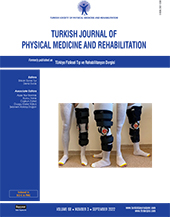Prescription of knee braces after anterior cruciate ligament reconstruction: Fact or fiction?
2 Department of Physical Medicine and Rehabilitation, Giresun University Faculty of Medicine, Giresun, Türkiye
3 Department of Orthopedics and Traumatology, Baltalimani Bone and Joint Diseases Education and Research Hospital, Istanbul, Türkiye
4 Department of Orthopedics and Traumatology, Midyat State Hospital, Mardin, Türkiye
5 Department of Orthopedics and Traumatology, Atlas University Faculty of Medicine, Istanbul, Türkiye DOI : 10.5606/tftrd.2022.8906 Objectives: This study aims to compare the clinical results of patients rehabilitated with or without a rehabilitative knee brace (RKB) after anterior cruciate ligament (ACL) reconstruction.
Patients and methods: This retrospective, comparative study was conducted at between January 2013 and December 2017. A total of 119 patients (112 males, 7 females; mean age: 32.0±8.6 years; range, 18 to 45 years) with acute ACL ruptures treated with arthroscopic ACL reconstruction and rehabilitated with (n=56) or without RKB (n=63) participated in the study. The minimum follow-up time was 24 months. The ACL quality of life (QoL) questionnaire, Lysholm Knee Scoring Scale, and Tegner Activity Level Scale were used for the evaluation of the QoL, knee function, and activity level, respectively. The time to return to sports was recorded. The side-to-side difference in the anterior translation of the tibia was measured using a KT-1000 arthrometer.
Results: The mean follow-up time was 38.4±9.1 (range, 24 to 56) months. Baseline demographics and clinical characteristics were similar between groups. Regarding QoL, knee function, and activity level, no significant difference was observed between patients who used RKB and those who did not use it at the postoperative 12th month (p=0.95, p=0.56, p=0.98, respectively) and the latest follow-up (p=0.21, p=0.73, p=0.99, respectively). The mean time to return to sports (nearly 11 months for both groups) and side-to-side difference in the anterior tibial translation at the latest follow-up was also similar between groups (p=0.15 and p=0.15, respectively). There was no graft rupture during the follow-up in both groups. The complication rates were 7.9% and 7.1% for no brace and brace groups, respectively, without a statistically significant difference (p=0.87).
Conclusion: According to the results of this study, there was no significant difference between the rehabilitative brace and no brace groups in clinical outcomes after ACL reconstruction.
Keywords : Anterior cruciate ligament reconstruction; knee brace, rehabilitation
















